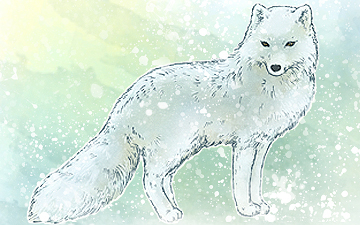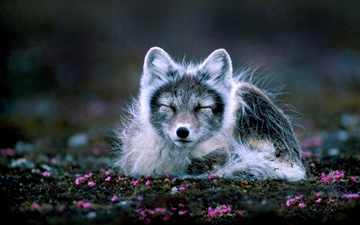The Arctic Fox (Alopex lagopus or Vulpes lagopus[2]), also known as the White Fox, Polar Fox or Snow Fox, is a small fox native to cold Arctic regions of the Northern Hemisphere and is common throughout the Arctic tundra biome. The Greek word alopex, (ἀλώπηξ) means a fox and Vulpes is the Latin version. Lagopus is derived from Ancient Greek lago (λαγως), meaning “hare“, + pous (πους), “foot” and refers to the hair on its feet.[3][4] Although it is often assigned to its own genus Alopex, Mammal Species of the World, as well as genetic evidence places it in Vulpes with the majority of the other foxes.[1][5]
The Arctic Fox lives in some of the most frigid extremes on the planet. Among its adaptations for cold survival are its deep, thick fur,[6] a system of countercurrent heat exchange in the circulation of paws to retain core temperature, and a good supply of body fat. The fox has a low surface area to volume ratio, as evidenced by its generally rounded body shape, short muzzle and legs, and short, thick ears. Since less of its surface area is exposed to the Arctic cold, less heat escapes the body. Its furry paws allow it to walk on ice in search of food. The Arctic Fox has such keen hearing that it can precisely locate the position of prey under the snow. When it finds prey, it pounces and punches through the snow to catch its victim. Its fur changes color with the seasons: in the winter it is white to blend in with snow, while in the summer months it changes to brown.[7]
(From Wikipedia, May 11th, 2010)
– – –
An animal that does not begin to shiver until temperatures reach -70 C, the arctic fox is one of the most superbly cold-adapted mammals. Its dense, multi-layered coat, which is several inches thick during winter, provides excellent heat insulation. Short ears, a short muzzle, and short limbs reduce heat loss by minimizing the amount of body surface area exposed to the cold. Even the pads on the soles of the feet are covered with fur to insulate them. Arctic foxes change color seasonally. Most populations are grayish-brown in summer and white in the winter. Others are dark brown or blush-gray in summer and “blue,” a steely blue-gray, in the winter. Like other foxes, arctic foxes tend to be solitary and mostly nocturnal. They hunt for lemmings, voles, birds, and other prey in the summer, but scavenge for carrion during the harsh winter, sometimes following polar bears or wolves to feed on the remains of caribou or seals the larger predators have killed.
(From EOL via Smithsonian NMNH)
– – –





